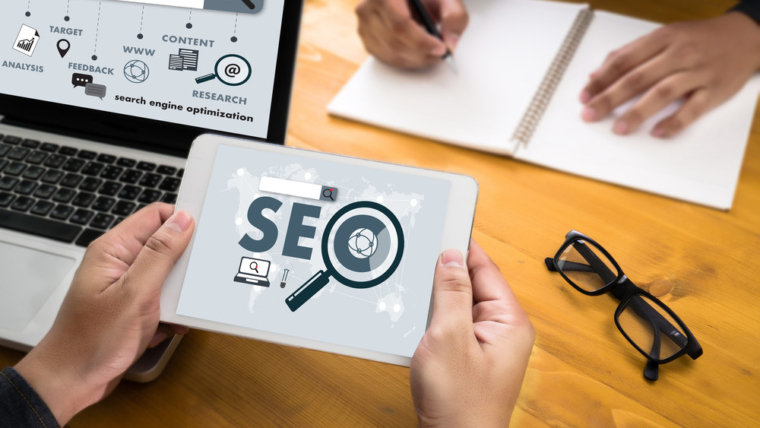Organic traffic from search engines is arguably the biggest source of traffic for your website. However, the likelihood of securing clicks from users depends heavily on how highly you rank.
Search engine optimization (SEO) is used to improve your ranking on the search engine results pages (SERPs). An effective SEO strategy includes both on-site and off-site strategies. While off-site strategies focus on building your backlink portfolio, on-site or on-page strategies, focus on optimizing more technical SEO elements, like meta tags and keywords.
In this guide, we’ll discuss why quality on-page content is important for both your target audience and search engines and walk you through some key on-page SEO factors that can help improve your rankings:
- What Is On-Page SEO and Off-Page SEO?
- Why Is On-Page SEO Important?
- How Do You Optimize Your On-Page SEO?
- You Don’t Have to Be an SEO Expert to Improve Your On-Page SEO
What Is On-Page SEO and Off-Page SEO?
Both on-page SEO and off-page SEO work together to build a site’s reputation and rankings on SERPs. When comparing both tactics, you’ll find that the two strategies complement each other nicely to build a strong site that users can easily find.
What Is On-Page SEO?
On-page SEO, also known as on-site SEO, is the practice of optimizing the content on your page (both the written word and the HTML source code) to make it as discoverable as possible.
You want to make it easy for Google, Bing, and other search engines to understand the material on the page to pair it with relevant search queries.
An on-page SEO strategy essentially organizes the content on the page so that search engine crawlers going over the material know what they’re looking at and can categorize the page appropriately.
What Is Off-Page SEO?
Off-page SEO describes SEO tactics that are outside your own website and impact its visibility across the web. Search engines want to know that the pages they return for users are trustworthy.
To better gauge a page’s authority, search engine algorithms look at the site’s apparent reputation regarding the rest of the digital ecosystem, including any backlinks that point to the page as a resource.
For example, one of the most common off-page optimization strategies is link building. Having other reputable sites link back to your page helps demonstrate to search engines that this particular page is well regarded by others.
Why Is On-Page SEO Important?
There are well over a billion websites currently online, which means that search engine algorithms must sort through enormous amounts of data to organize web content and serve users with the content that will appeal most to them.
With quality on-page optimization, you help search engines connect your content’s relevance to the given query or keyword you’re trying to rank for.
Google regularly updates its algorithm, improving its ability to understand not only the intent behind users’ queries but also websites and the experiences they deliver to those who click.
For example, Google has made updates to uncover and punish duplicate content, encourage sites to be mobile-ready, and emphasize the importance of user experiences, demonstrating its commitment to continuous improvements.
How Do You Optimize Your On-Page SEO?
Optimizing for both search engine algorithms and users requires a few strategies. Below, we’ll walk you through what you need to know to begin improving your own on-page SEO:
- Step 1: Understand Google’s Criteria
- Step 2: Use Your Target Keyword in the First Paragraph
- Step 3: Wrap Titles and Subtitles in H1 and H2 Tags
- Step 4: Prioritize Outbound and Internal Linking Opportunities
- Step 5: Optimize URLs
- Step 6: Optimize Title Tags
- Step 7: Add and Improve Meta Descriptions
- Step 8: Revise and Write SEO On-Page Content
- Step 9: Add and Optimize Images
- Step 10: Optimize for User Engagement
Step 1: Understand Google’s Criteria
Before you can begin to improve your on-page SEO, you must first understand how Google search works — specifically its algorithm. The search engine giant focuses on a few areas to determine the best content to serve to the user making a query:
- It looks at the overall experience the person has when they first land on the page. With the Core Web Vitals update, Google will be paying particularly closer attention to the first impression of the site, such as the site speed time and how quickly people can interact with the page.
- Google closely looks at the content itself. It wants to identify the content relevant to the query, which means it will examine the keywords and phrases used throughout the material.
- The search engine wants to see how people engage with the content. Do they click off right away? Do they spend time moving around the site? This helps to indicate if people landing on the page find it helpful.
- Finally, Google wants high-quality content that is also reliable and trustworthy. This means it will want to see authoritative material.
With proper on-page SEO tools and strategies, you can improve your ability to meet Google’s criteria and your ranking position on the SERPs. Our On Page SEO checker assists with specific technical edits, like appropriate title tags and no duplicate content.

Step 2: Use Your Target Keyword in the First Paragraph
Using your main target keyword in the first paragraph allows you to make your purpose and topic clear from the beginning. Remember that the search engine algorithm looks for keywords and terms that provide it with clues about your content and the type of information it contains.
Providing a central keyword in the first paragraph of the content will ensure that you make your intention clear. As you build out the content, begin to incorporate semantic keywords and/or synonyms with a strong relationship to the main keyword and that Google expects to see.
Perform keyword research and help search engines know which words are important for the industry. The keyword density of the material should remain natural so that the content sounds smooth.
Step 3: Wrap Titles and Subtitles in H1 and H2 Tags
H1 and H2 tags help draw the attention of search engine spiders to your page title and the hierarchy you’ve created in your content. It helps make the content outline clear for the algorithm so that it understands how you’ve organized your text.
The header and subheadings also provide key hints about the material included in the paragraphs that follow the heading, making it easier for the search engine to register the important information about your material.
Remember that Google also wants to see content that delivers a positive user experience. Content that appears as a giant wall of text can be hard to read. The clear organization provides clues about the content by also demonstrating an easy-to-read format and makes it simple for readers to find the parts that matter the most to them and their query.
Creating a clear structure of H1 and H2 tags pleases search engines and users. Research from our State of Content Marketing Report indicates that content containing this clear hierarchy is more likely to be high performing.
Step 4: Prioritize Outbound and Internal Linking Opportunities
Linking provides you with the key to showing Google how your material relates to your site and the larger part of the digital ecosystem. Linking to external sources is known as outbound links.
Content creators will often use these links to provide additional information about a topic or provide an authoritative source for something they just said. Since these links can help add authority to your site and improve the experience for users interested in this particular topic, marketers are wise to include them in a marketing strategy.
On the other hand, internal linking involves linking to the content on your own website. If you touch on a particular topic where you have other content that covers more deeply, providing an internal link can benefit you. The link will make it easier for searchers to further engage with your site, as they may click on the link and continue to explore the site — reducing your bounce rate and encouraging brand appreciation.
These links also provide Google with information about your site architecture. Google can see how the content on the site relates to each other and the depth of content on particular topics, which can further boost your authoritativeness.
Step 5: Optimize URLs
The URL structure of your webpage also provides helpful SEO benefits. Specifically, when you create a URL that includes important keywords, it becomes even more obvious the topic that this particular page will cover.
Both search engines and users can look at the URL and feel confident knowing the topic of a particular page. This can encourage users to click from the SERP to this particular result, increasing your traffic.
Step 6: Optimize Title Tags
The title tag appears within the search engine result below the URL but above the meta description.

The title tag provides users looking at the results page with information about the content of your page. These users look to the title tag to better determine if your content will meet their needs. Therefore, a strong title tag that contains important keywords will encourage more clicks and traffic.
Step 7: Add and Improve Meta Descriptions
The meta description or meta tag refers to the brief description found underneath the URL and title of the page on the SERP when your site appears in the search results. This description provides more information about the content you have on the page. When keywords in your description also align well with the searches that this particular user makes, it demonstrates that your page contains relevant information for them.
Think of the meta description as your opportunity to advertise your page to the user. Make the material actionable and encourage them to click on your site.
Step 8: Revise and Write SEO On-Page Content
The Google algorithm is not static, as it regularly changes to better reflect user search intent and new search practices like voice search. Since the algorithm changes, brands must also be willing to regularly shift their SEO practices to align with those needs.
Regularly revisit your past content and look for ways to improve it. Using an on-page SEO checker will also make it easier for you to run through the list of information and ensure that you have hit the important points.
Keep in mind, though, that even though the algorithm changes, the goal of serving up quality content to users does not.
Step 9: Add and Optimize Images
Customers appreciate images and respond by showing higher signs of engagement. Focus on adding images that elevate your content, including any you can create yourself that reflect what you discuss on a specific page.
The images you select should also be optimized. This means:
- Making sure they load quickly by using strategies such as reducing the file size and implementing lazy loading.
- Creating excellent alt tags that tell the search engine what the image is so that Google can see it as a valuable piece of content on your site. The alt text also assists visually impaired people using the site, ensuring they can fully appreciate your content.
- Selecting titles and file names for your images that reflect the image and keywords you want to incorporate into the content.
Step 10: Optimize for User Engagement
The content on your page should draw in the reader to boost their engagement. You want to improve their dwell time on the site while also decreasing your bounce rate. These factors demonstrate to Google that customers appreciate your content. It also lays the foundation for a relationship with this particular visitor, who will hopefully become a lead moving forward.
On your page, you can create content that boosts engagement by:
- Using clear headlines that indicate the topic of each section of your content to boost readability.
- Using bullets and lists to make the material easier to scan.
- Incorporating video into your content.
- Creating relevant calls-to-action (CTAs) that encourage users to click and access gated content.
- Having a clean and crisp layout that doesn’t distract users from your content.
- Ensuring the page speed is fast by following load time best practices.
You Don’t Have to Be an SEO Expert to Improve Your On-Page SEO
When it comes to building a strong website that ranks well on the SERPs, you don’t have to be a technical SEO expert writing your own HTML to succeed.
Understanding the basic concept of what the Google algorithm wants to see and what it considers to be a ranking factor can help you make better decisions for your site and boost your SERP position.
By arming yourself with helpful equipment, such as our SEO toolkit, and the right metrics, you’ll be able to continually produce new content optimized for both search engines and searchers.
Source: https://www.semrush.com/blog/on-page-seo/




